Naghmeh Bandari received her Bachelor’s and Master’s degrees in biomedical engineering from Amirkabir University of Tehran, Iran, where she served as a Certified Medical Device Technical Supervisor for six years. She is a doctoral candidate of Mechanical Engineering at the Optical-Bio-MEMS and Robotic Surgery Labs. She is also a fellow of Surgical Innovation at the Natural Sciences and Engineering Research Council of Canada (NSERC) CREATE program for Innovation-at-the-Cutting-Edge (ICE). Her research focuses on the development of optical tactile sensors and micro-optical mechanical systems for robotic and surgical applications.
Blog post
Surgical robots: the value proposition and top players in the game
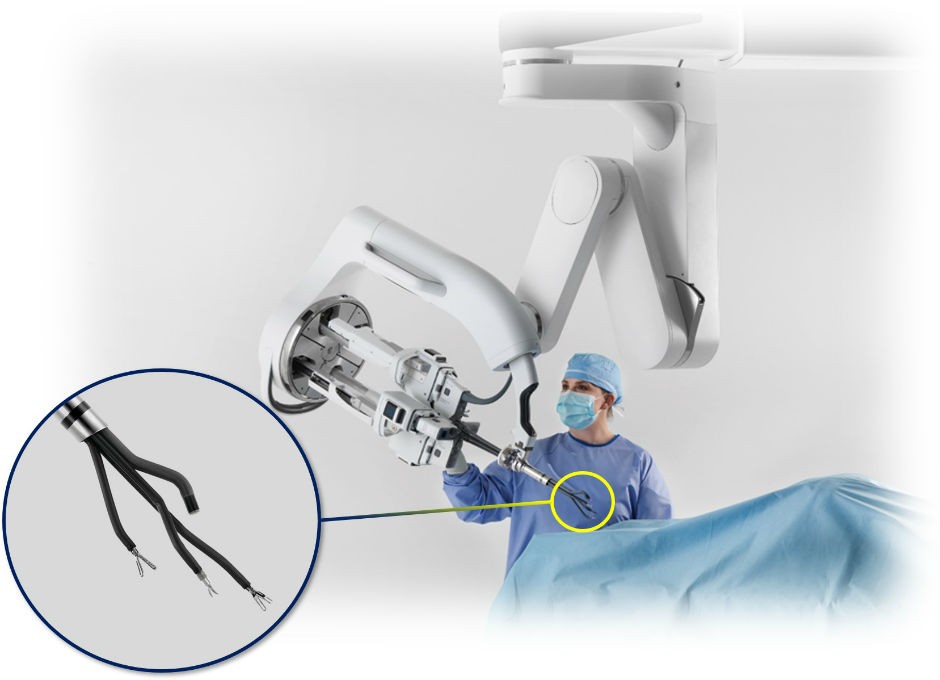 Da Vinci SP surgical robot | Photo by Intuitive Surgical Inc.
Da Vinci SP surgical robot | Photo by Intuitive Surgical Inc.
With the debut of minimally invasive surgery back in the 80s, laparoscopic surgery was introduced as a replacement for open surgery. Open surgery is associated with long anesthesia time, large bleeding and skin incision, which exacerbate the risk of post-surgery infection. In contrast, with laparoscopic surgery, surgeons were able to perform complex surgeries — for example, on a heart or brain — through incisions as small as a couple of centimetres.
Robotic surgery was built upon the principles of laparoscopic surgery and accesses the internal organs through small body orifices or skin incisions, named ports. The first U.S. Food and Drug Administration-approved surgical robot was Da Vinci, which began marketing in the U.S. in 2000. Robotic surgery offers several advantages over conventional laparoscopic surgery, including:
- greater range of motion and dexterity for the surgeon
- higher quality images with more computerized features
- shorter hospital stays, as well as less blood loss, risk of infection, pain and recovery time
Performing surgery robotically is like playing a video game. In a video game, the player uses a joystick to control the character (or virtual robot) to complete one or multiple tasks. In robotic surgery, the surgeon (or player) uses a control panel like a joystick to control a robot (or character) to fulfill one or multiple maneuvers (or tasks).
As different games require various character powers, different surgeries need several specifications in the surgical robot. For example, a robot suitable for pituitary gland tumor resection must be so slick that it can enter the brain through the nostrils, while a robot for hip joint replacement must be strong and big enough to handle very large forces needed for drilling through femur bone.
Currently, there are specialized surgical robots developed and cleared for different surgeries. Here are my summaries of the most common surgical robots.
1. The Da Vinci Xi, SP and Ion surgical systems
Intuitive launched da Vinci Xi in 2014. Xi is the new generation of the classic da Vinci surgical robot with a remote-control multi-arm structure. Xi is suitable for any type of laparoscopic surgery within the abdomen and pelvis.
With Xi, surgeons have access to new active and passive surgical instruments, 3D stereoscopic vision on the console and a multitude of new diagnostic and interventional features. Although Xi has a slightly smaller footprint than X, it still is a stationary system that needs dedicated space to be up and running; thus, is not a mobile robot.
Also, Intuitive has a model in the family named da Vinci SP, which stands for single port. This new robot performs surgeries in confined spaces such as the thorax. It allows the surgeon to introduce a camera and three wristed instruments with spatial control through a 2.5-centimetre incision. Da Vinci SP is incredibly eye-catching in design and, in contrast to its ancestors, is extremely slim and low profile.
To catch up in the race for robotic interventions, Intuitive also introduced Ion, a bronchoscopic biopsy system with robotic precision, equipped with 3D navigation and unprecedented precision and dexterity in bronchial biopsy. Ion is integrated with pre-operative CT-scans for visualizing the bronchoscope intraoperatively. Also, it has enhanced artificial intelligence-based diagnostic features that streamline surgeries for both surgeons and patients.
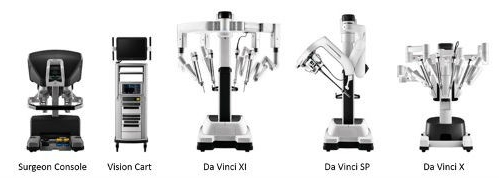 Da Vinci family robots | Photo by Intuitive Surgical Inc.
Da Vinci family robots | Photo by Intuitive Surgical Inc.
2. Versius
Cambridge Medical Robotics was the first UK-based company to launch a commercial surgical robot. Versius is the first commercial mobile surgical robot for general laparoscopic surgery. Being mobile in the realm of robotic surgery means that surgeons can place the robotic arm(s) anywhere around the patient for better access.
Unlike da Vinci, Versius’ arms are stand-alone and used based on need. This means surgeons can use two, three, four or more arms in combination with multiple control consoles to make multi-surgeon robotic sessions possible. Another unique feature of Versius is its haptic feedback at the control console, which increases the surgeon’s situational awareness by relaying the forces between instruments and the patient to the surgeon’s hands.
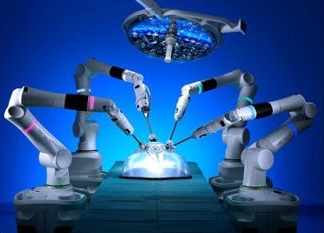 Versius robotic surgery system | Photo by Cambridge Medical Robotics Ltd.
Versius robotic surgery system | Photo by Cambridge Medical Robotics Ltd.
3. Hugo robotic surgery system
Being late to the game doesn’t necessarily mean you lose. Medtronic finally unveiled its robotic platform for laparoscopic surgery, Hugo. While not impressive at first because of its resemblance to da Vinci and Versius, the robot is promising given that Medtronic is one of the top top technology holdings in the world.
Like Versius, Hugo is mobile and modular, yet its arms use the remote centre of rotation principle used by da Vinci. With Versius and da Vinci systems already at two ends of the customer spectrum, Hugo has some tough competition.
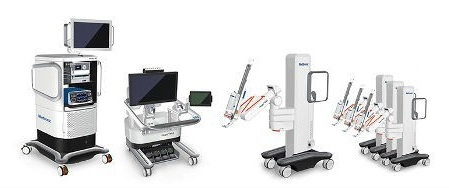 Hugo robotic surgery system | Photo by Medtronic.
Hugo robotic surgery system | Photo by Medtronic.
4. Sensei robotic system
Hansen Medical — now a part of Auris Health — unveiled its Sensei Robotic Catheter System at the 14th annual Boston Atrial Fibrillation Symposium in 2009. Hansen Medical developed Sensei for interventional electrophysiology procedures, treating patients with atrial fibrillation, or heart arrhythmia.
Along with Sensei, the first robotic cardiac catheter, Artisan, launched in collaboration with Sensei. With Sensei, surgeons can perform cardiac ablation procedures with unprecedented dexterity, precision and safety. Seeing as surgeons have to perform cardiac interventions under live X-ray, the remote-control setup of Sensei allows them to stay away from the X-ray exposure zone and perform the surgery with enhanced safety.
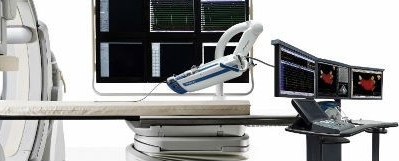 Sensei robotic system | Photo by Auris Health.
Sensei robotic system | Photo by Auris Health.
5. The CorPath system
Like Sensei, CorPath by Former Corindus Inc. — now a Siemens-Healthineers company — is a robotic system for cardiovascular intervention surgeries. Unlike Sensei, the CorPath system can work with conventional vascular catheters and guidewires. This specification broadens CorPath’s use in all catheter-based surgeries, including neurovascular, cardiovascular, peripheral vascular and extremities.
However, CorPath has only been cleared for neuro-, cardio- and peripheral vascular interventions so far. Partnered with Siemens-Healthineers, projections estimate that Siemens’s excellence and technology in medical imaging will soon revolutionize robotic cardiovascular intervention procedures and increase the pace of adoption of this technology globally.
Also, with the expansion of 5G internet, there is hope that we may see the emergence telerobotic cardiovascular interventions for rural and under-developed areas.
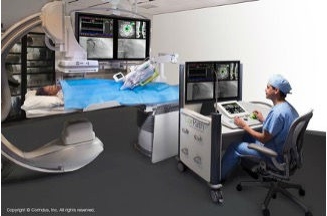 The CorPath system | Photo by Corindus-Siemens-Healthineers.
The CorPath system | Photo by Corindus-Siemens-Healthineers.
6. Monarch platform
In 2016, Auris Health — now a Johnson-and-Johnson company (J&J) — introduced its robot for bronchoscopic biopsy, Monarch. Monarch uses two robotic arms to supply steady and precise control for bronchoscopes. Empowered with real-time 3D navigation, an in-scope camera and an Xbox-like control joystick, surgeons experience a realistic gaming-like surgical procedures.
Marking, aiming and shooting at suspicious tissue with Monarch gives an unprecedented ability to identify cancer-alike nodules inside a patient’s lungs. Joining J&J — especially with lung ablation solutions from Ethicon — gives Monarch the boost it needs to become the gold standard for treatment in the market.
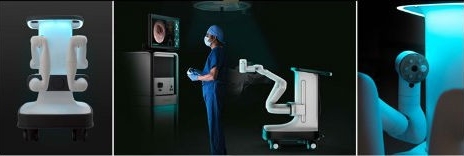 Monarch platform | Photo by Auris Health Inc.
Monarch platform | Photo by Auris Health Inc.
About the author
